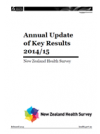The New Zealand Health Survey (NZHS) conducts face-to-face interviews with over 13,000 adults and the parents/ caregivers of over 4000 children annually. The survey collects a wealth of information on the health and wellbeing of New Zealanders. Every year it includes a core set of questions, which help the Ministry of Health identify key issues and monitor trends.
This report presents the annual update of key results from the 2014/15 NZHS, which collected data from July 2014 to June 2015. It includes data for key survey indicators, providing a snapshot of health behaviours, health status and access to health care for both adults and children. These key indicators help highlight at-risk groups and focus attention on important issues, as well as identifying areas for further research.
Key Results
Health status, health behaviours and risk factors
- The majority of New Zealanders report being in good health.
- The smoking rate is decreasing slowly. High smoking rates persist in Māori and Pacific adults and in adults living in the most deprived areas.
- The adult obesity rate has increased since 2011/12. Furthermore the percentage of adults who are morbidly obese has been steadily increasing.
- Hazardous drinking rates have risen again, returning to the 2006/07 rate.
- Adults living in the most deprived areas have higher rates of most health risks including smoking, hazardous drinking, not eating at least the recommended servings of vegetables and fruit daily, physical inactivity and obesity.
Health conditions
- Rates of chronic pain and arthritis (a cause of chronic pain) are rising.
- Rates of psychological distress (indicative of anxiety or depressive disorders) are high among Māori and Pacific adults, and in adults living in the most deprived areas.
Access to health care
- Rates of unmet need for primary health care are similar to 2011/12.
- Unmet need for primary health care is more common among Māori and Pacific adults and children, and in those living in the most deprived areas.
- Cost is more likely to be a barrier to visiting a GP for younger adults than adults aged 65 years and over.
- Cost is more likely to be a barrier to accessing after-hours medical centres and filling prescriptions, for adults and children living in the most deprived areas, than for those living in the least deprived areas.
Oral health
- Māori and Pacific children and adults, and those living in the most deprived areas have high rates of tooth extractions in the past year.
- Most children have visited a dental health care worker in the past year.
- Nearly half of adults with natural teeth visited a dental health care worker in the past year.

